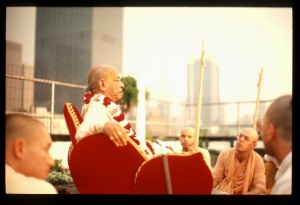CC Madhya 2.47 (1975): Difference between revisions
(Vanibot #0027: CCMirror - Mirror CC's 1996 edition to form a basis for 1975) |
(Vanibot #0020: VersionCompareLinker - added a link to the Version Compare feature) |
||
| Line 2: | Line 2: | ||
<div style="float:left">'''[[Sri Caitanya-caritamrta (1975)|Śrī Caitanya-caritāmṛta (1975)]] - [[CC Madhya (1975)|Madhya-līlā]] - [[CC Madhya 2 (1975)|Chapter 2: The Ecstatic Manifestations of Lord Śrī Caitanya Mahāprabhu]]'''</div> | <div style="float:left">'''[[Sri Caitanya-caritamrta (1975)|Śrī Caitanya-caritāmṛta (1975)]] - [[CC Madhya (1975)|Madhya-līlā]] - [[CC Madhya 2 (1975)|Chapter 2: The Ecstatic Manifestations of Lord Śrī Caitanya Mahāprabhu]]'''</div> | ||
<div style="float:right">[[File:Go-previous.png|link=CC Madhya 2.46 (1975)|Madhya-līlā 2.46]] '''[[CC Madhya 2.46 (1975)|Madhya-līlā 2.46]] - [[CC Madhya 2.48 (1975)|Madhya-līlā 2.48]]''' [[File:Go-next.png|link=CC Madhya 2.48 (1975)|Madhya-līlā 2.48]]</div> | <div style="float:right">[[File:Go-previous.png|link=CC Madhya 2.46 (1975)|Madhya-līlā 2.46]] '''[[CC Madhya 2.46 (1975)|Madhya-līlā 2.46]] - [[CC Madhya 2.48 (1975)|Madhya-līlā 2.48]]''' [[File:Go-next.png|link=CC Madhya 2.48 (1975)|Madhya-līlā 2.48]]</div> | ||
{{CompareVersions|CC|Madhya 2.47|CC 1975|CC 1996}} | |||
{{RandomImage}} | {{RandomImage}} | ||
==== TEXT 47 ==== | ==== TEXT 47 ==== | ||
<div class="verse"> | <div class="verse"> | ||
:yāte vaṁśī-dhvani-sukha, | :yāte vaṁśī-dhvani-sukha, nā dekhi' se cāṅda mukha, | ||
:yadyapi nāhika | :yadyapi nāhika 'ālambana' | ||
:nija-dehe kari prīti, | :nija-dehe kari prīti, kevala kāmera rīti, | ||
:prāṇa-kīṭera kariye dhāraṇa | :prāṇa-kīṭera kariye dhāraṇa | ||
</div> | </div> | ||
| Line 20: | Line 19: | ||
<div class="synonyms"> | <div class="synonyms"> | ||
yāte—in which; vaṁśī-dhvani-sukha—the happiness of hearing the playing of the flute; nā | yāte—in which; vaṁśī-dhvani-sukha—the happiness of hearing the playing of the flute; nā dekhi'-not seeing; se—that; cāṅda mukha—moonlike face; yadyapi—although; nāhika—there is not; 'ālambana'-the meeting of the lover and beloved; nija—own; dehe—in the body; kari—I do; prīti—affection; kevala—only; kāmera—of lust; rīti—the way; prāṇa—of life; kīṭera—of the fly; kariye—I do; dhāraṇa—continuing. | ||
</div> | </div> | ||
| Line 27: | Line 26: | ||
<div class="translation"> | <div class="translation"> | ||
"Even though I do not see the moonlike face of Kṛṣṇa playing on His flute and although there is no possibility of My meeting Him, still I take care of My own body. That is the way of lust. In this way, I maintain My flylike life. | |||
</div> | </div> | ||
| Line 34: | Line 33: | ||
<div class="purport"> | <div class="purport"> | ||
In this connection, Śrīla Bhaktisiddhānta Sarasvatī Ṭhākura says that the lovable Supreme Lord is the supreme shelter. The Lord is the supreme subject, and the devotees are the object. The coming together of a subject and object is called ālambana. The object hears, and the subject plays the flute. That the object cannot see the moonlike face of Kṛṣṇa and has no eagerness to see Him is the sign of being without ālambana. Externally imagining such a thing simply satisfies | In this connection, Śrīla Bhaktisiddhānta Sarasvatī Ṭhākura says that the lovable Supreme Lord is the supreme shelter. The Lord is the supreme subject, and the devotees are the object. The coming together of a subject and object is called ālambana. The object hears, and the subject plays the flute. That the object cannot see the moonlike face of Kṛṣṇa and has no eagerness to see Him is the sign of being without ālambana. Externally imagining such a thing simply satisfies one's lusty desires, and thus one lives without purpose. | ||
</div> | </div> | ||
Latest revision as of 12:26, 27 January 2020

A.C. Bhaktivedanta Swami Prabhupada
TEXT 47
- yāte vaṁśī-dhvani-sukha, nā dekhi' se cāṅda mukha,
- yadyapi nāhika 'ālambana'
- nija-dehe kari prīti, kevala kāmera rīti,
- prāṇa-kīṭera kariye dhāraṇa
SYNONYMS
yāte—in which; vaṁśī-dhvani-sukha—the happiness of hearing the playing of the flute; nā dekhi'-not seeing; se—that; cāṅda mukha—moonlike face; yadyapi—although; nāhika—there is not; 'ālambana'-the meeting of the lover and beloved; nija—own; dehe—in the body; kari—I do; prīti—affection; kevala—only; kāmera—of lust; rīti—the way; prāṇa—of life; kīṭera—of the fly; kariye—I do; dhāraṇa—continuing.
TRANSLATION
"Even though I do not see the moonlike face of Kṛṣṇa playing on His flute and although there is no possibility of My meeting Him, still I take care of My own body. That is the way of lust. In this way, I maintain My flylike life.
PURPORT
In this connection, Śrīla Bhaktisiddhānta Sarasvatī Ṭhākura says that the lovable Supreme Lord is the supreme shelter. The Lord is the supreme subject, and the devotees are the object. The coming together of a subject and object is called ālambana. The object hears, and the subject plays the flute. That the object cannot see the moonlike face of Kṛṣṇa and has no eagerness to see Him is the sign of being without ālambana. Externally imagining such a thing simply satisfies one's lusty desires, and thus one lives without purpose.